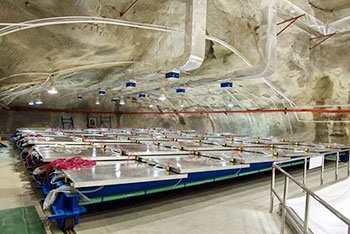Daya Bay Neutrino Experiment Releases Precision Measurement of Subatomic Shape Shifting and New Result on Differences among Neutrino Masses

Daya BayThe international Daya Bay Collaboration announced new results about the transformations of elusive, ghostlike neutrinos, particles that carry invaluable clues about the makeup of the early universe. The latest findings include their first data on how neutrino oscillation – in which neutrinos mix and change into other “flavors,” or types, as they travel – varies with neutrino energy, allowing scientists to measure a key difference in neutrino masses known as “mass splitting.”
The new results are based on four times the data, with twice the precision, of the first Daya Bay results released last year, which established the value of the third and final neutrino “mixing angle.” Mass splitting represents the frequency of neutrino oscillation. Mixing angles, another measure of oscillation, represent the amplitude. Both are crucial for understanding the nature of neutrinos.
Understanding the subtle details of these neutrino oscillations and other properties of these shape-shifting particles may help answer some of the most mysterious questions about the universe.
The Daya Bay Experiment is located close to the Daya Bay and Ling Ao nuclear power plants in China, 55 kilometers northeast of Hong Kong. The Daya Bay Collaboration includes more than 200 scientists from six regions and countries.
Measuring Neutrino Mass and Flavors

Resistive Plate Chamber - Daya Bay ExperimentNeutrinos come in three “flavors” (electron, muon, and tau) and each of these exists as a mixture of three masses. Measuring oscillations of neutrinos from one flavor to another gives scientists information on the probability of each flavor occupying each mass state (the mixing angles) and the differences between these masses (mass splitting).
Daya Bay measures neutrino oscillation with electron neutrinos – actually antineutrinos, essentially the same as neutrinos for the purpose of these kinds of measurements. Millions of quadrillions of them are created every second by six powerful reactors. As they travel up to two kilometers to underground detectors, some seem to disappear.
The missing neutrinos don’t vanish; instead they have transformed, changing flavors and becoming invisible to the detectors. The rate at which they transform is the basis for measuring the mixing angle, and the mass splitting is determined by studying how the rate of transformation depends on the neutrino energy.
Daya Bay’s first results were announced in March 2012 and established the unexpectedly large value of the mixing angle theta one-three (θ13), the last of three long-sought neutrino mixing angles. The new results from Daya Bay put the precise number for that mixing angle at sin22θ13=0.090 plus or minus 0.009. The improvement in precision is a result of having more data to analyze and having the additional measurements of how the oscillation process varies with neutrino energy.
The energy-dependence measurements also open a window to the new analysis that will help scientists tease out the miniscule differences among the three masses. The KamLAND experiment in Japan, and other solar neutrino experiments have previously measured the mass splitting Δm221 by observing the disappearance of electron antineutrinos from reactors about 100 miles from the detector and the disappearance of neutrinos from the sun. The MINOS experiment in the U.S., and the Super-K and T2K experiments in Japan, have determined the effective mass splitting |Δm2μμ| using muon neutrinos. Daya Bay scientists have now measured the magnitude of the mass splitting |Δm2ee| to be (2.54±0.20)×10-3 eV2.
The result establishes that the electron neutrino has all three mass states and is consistent with that from muon neutrinos measured by MINOS. Precision measurement of the energy dependence should further the goal of establishing a “hierarchy,” or ranking, of the three mass states for each neutrino flavor.
University of Houston's Daya Bay Connection
The University of Houston (UH) is one of a dozen U.S. institutions working on Daya Bay since the beginning. Under the leadership of physics professor Kwong Lau, the UH group contributed to the RPC (Resistive Plate Chamber) part of the muon detector of the experiment.
The RPCs detect residual cosmic muons, which sneaked through the mountain, and help to remove them from contaminating the sample of genuine neutrino interactions. The muon-induced contamination are one of the main sources of background limiting the ultimate precision.
“It is amazing that Daya Bay is now making precision measurement of theta one-three whose value was virtually unknown only a few years ago,” said Lau.
Lisa Whitehead, UH assistant professor of physics and co-convener of the Cosmogenic Background Group in Daya Bay added “The muon system will help us understand the cosmogenic background to the theta one-three measurement.
”The UH group consists of three Department of Physics faculty members: Lau, Whitehead, who joined UH two years ago after working on Daya Bay at BNL for the past 4 years, and professor Lawrence Pinsky.
“Daya Bay is a successful international collaboration of 250+ scientists from around the world working toward a common goal,” said Lau, who served as chair of the Institutional Board of the collaboration for the last 5 years. Two postdoctoral fellows, Drs. Dawei Liu and Hu Liu, and two graduate students, Shih-Kai Lin and Ian Mitchell, from UH are also members of Daya Bay.
The latest results from the Daya Bay Collaboration were announced at the XVth International Workshop on Neutrino Factories, Super Beams and Beta Beams (NuFact2013) in Beijing, China.
For additional background information on the Daya Bay Neutrino Experiment, visit the experiment’s website at http://dayabay.ihep.ac.cn/.
- Press release issued by the Berkeley Lab with additional information provided by Kwong Lau of University of Houston